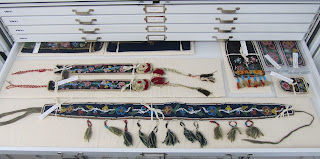
In the front lobby, they meet some of the most classic Nintendo characters - entering a raffle with the Ice Climbers, throwing fireballs with Mario and Luigi, meeting Princess Peach. Packing peanuts – the snow that the Ice Climbers have to climb – litter the floor, to be tracked all around the gallery, but nobody seems to mind. Today, the museum is hardly the Museum: it’s instead a place of characters and costumes and candy, and everybody knows it.
 When
they leave the front lobby, the children make their own Pokemon in the Devonian
and Pennsylvanian, aided by the Pokemon trainers, who have put together an
impressive array of characters. Although
the Ice Climbers might not be familiar to all children, Pokemon is hard to
miss. Elbowing each other for room at
the tables, the children color in their own Pokemon cards – some very detailed,
some a quick dash - and then hand them to their parents to carry.
When
they leave the front lobby, the children make their own Pokemon in the Devonian
and Pennsylvanian, aided by the Pokemon trainers, who have put together an
impressive array of characters. Although
the Ice Climbers might not be familiar to all children, Pokemon is hard to
miss. Elbowing each other for room at
the tables, the children color in their own Pokemon cards – some very detailed,
some a quick dash - and then hand them to their parents to carry.
In the
Meskwaki area, decorated with fluffy clouds to represent the world of Kid
Icarus, the children wrap aluminum foil around paper plates to make mirror
shields, assisted by Palutena and Medusa, the main goddesses from the
game. When they finish, Pit, the game’s
hero, shines a flashlight on the shield to make it shine, and the children head
to the Ecology section to build rockets with the Pikmin.
 There’s
more fun to be had downstairs – where the Geoscience department has set up shop
– and in Bird and Mammal Halls – where you can find rupees with Zelda and play skeeball
with the cast of Earthbound – but no matter where you decide to go, there’s
always something to do. Each child
leaves with an assortment of crafts – shields, Pokemon, rockets – and an
evening well-spent. And since Halloween
falls on a Wednesday this year, it’s only the start of an extravaganza.
There’s
more fun to be had downstairs – where the Geoscience department has set up shop
– and in Bird and Mammal Halls – where you can find rupees with Zelda and play skeeball
with the cast of Earthbound – but no matter where you decide to go, there’s
always something to do. Each child
leaves with an assortment of crafts – shields, Pokemon, rockets – and an
evening well-spent. And since Halloween
falls on a Wednesday this year, it’s only the start of an extravaganza.
Halloween
is that rare holiday where, for a few hours, you can pretend to be someone
else. No matter the strength of the
disguise – after all, the scary looking ghoul is always a child underneath –
it’s about the fun of playing pretend, of dressing up, of trick-or-treating and
pumpkins and ghosts. For a few hours,
you can climb with the Ice Climbers or write yourself into the Legend of Zelda;
it only happens once a year, which makes it all the more worthwhile.
-Written by MNH Volunteer Catherine Babikian
-Written by MNH Volunteer Catherine Babikian








